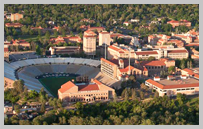Who
The “Research & Innovation Office Bulletin” was primarily developed and implemented by Chris Yankee and Allison Miller, who comprise the CU Boulder Research & Innovation Office (RIO) communication team.
Additional contributors included Karen Regan, Victor Bright, Ryan Reeves and numerous other members of the RIO team. Also, the CU Boulder Strategic Relations team assisted; especially Jessica Raab, Erin Frazier, Jon Leslie and Julie Poppen.
We received encouragement, strategic advice and leadership support from Vice Chancellor for Research & Innovation Terri Fiez.
What
The Research & Innovation Office team developed the RIO Bulletin to create one communication stream to consistently and effectively deliver critical research-related information to the CU Boulder research community, reduce the number of emails and administrative burden on faculty leaders who were previously asked to filter opportunities and funnel appropriately, and strengthen the campus’ affiliation with RIO as a provider of research information and resources.
- Most importantly, the Bulletin will increase excellence and productivity across the research enterprise by connecting critical information directly with those who need it, in a way that can be measured, increasingly targeted (through subscriptions and unsubscribes), and optimized through content, format and process improvements.
- The Bulletin saves time for campus leaders–specifically Deans, Department Chairs and Program Directors–who directly received regular information and updates in the past, but were responsible for digesting them and filtering them accordingly.
- The Bulletin is a business process improvement for a number of people on the RIO team–as well as communicators across campus who need to reach this audience–who now have a single channel and process to address virtually every communication need related to the research community.
- The Bulletin’s aggregation of related information and opportunities into one bi-weekly communication on Tuesdays represents a business process improvement for the campus by significantly reducing the volume of emails across campus, while integrating into the campus communication strategy, which encourages department or functional communications to take place on Tuesdays.
Why
CU Boulder did not have a comprehensive communication channel to ensure that the research community across campus received critical research funding and support information on a timely and consistent basis. Many channels combined to deliver much of this information, but the previous approach had many drawbacks.
- Since channels varied depending on the communicating unit and the relevant audiences, potential recipients of the information never knew where information might be found; it might come through direct emails, emails filtered by department leadership, the Research Administrators listserv, Administrative eMemos, CU Boulder Today, campus calendars, and sometimes not at all.
- Much of the information would be sent via emails (approximately 120 each year) to “Deans, Department Chairs and Program Directors” but these emails required leadership to review, filter and send information to appropriate faculty–a step that burdened leadership and likely often wasn’t completed because of the demands placed on this group and the time-sensitive nature of the funding opportunities, events and other calls to action.
- The tools originally used to distribute information via email–unlike Salesforce/Marketing Cloud, the campus tool we use for the Bulletin–did not provide sophisticated marketing capabilities like email preference management (subscribing and unsubscribing) and analytics capabilities, so it was impossible to measure almost any aspect of performance.
- Since the channels for communicating were so different, the information communicated to each group was quite tailored, resulting in a high volume of emails across campus with little ability to aggregate multiple opportunities or updates into fewer communications for people to look for and focus on.
Where
The most exciting part of the RIO Bulletin is that it delivers information from all areas of the CU Boulder campus to members of the research community, regardless of organizational unit or work area on campus. If other CU campuses don’t yet have a campus-wide communication tool to support the research community, the RIO Bulletin could serve as a model to consider. This possibility is part of our reason for sharing.
When
The first bi-weekly RIO Bulletin was emailed to nearly 3,900 faculty and staff on March 21, 2017.
The first edition metrics imply an incredibly successful start:
- Open rate of 48.1%! (30% would be considered good for many communications like this and 40% would be considered excellent.)
- 400 more new visitors to the RIO site the week of the Bulletin vs. previous week
- 110% increase in unique visits to Limited Campus Competitions page vs. previous week
- 12% increase in unique visits to RIO homepage vs. previous week
- Zero unsubscribes with nearly 3,900 emails delivered




